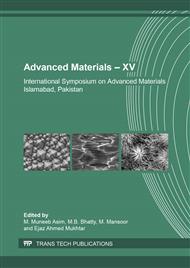[1]
A. González, E. Goikolea, J. A. Barrena, R. Mysyk, Review on supercapacitors: technologies and materials, Renew. Sustain. Ener. Rev., 58 (2016) 1189–1206.
DOI: 10.1016/j.rser.2015.12.249
Google Scholar
[2]
F. Wang, S. Xiao, Y. Hou, C. Hu, L. Liu, Y. Wu, Electrode materials for aqueous asymmetric supercapacitors, RSC Adv., 3 (2013) 13059–13084.
DOI: 10.1039/c3ra23466e
Google Scholar
[3]
J. Yan, E. Khoo, A. Sumboja, P. S. Lee, Facile coating of manganese oxide on tin oxide nanowires with high-performance capacitive behavior., ACS Nano, 4 (2010) 4247–55.
DOI: 10.1021/nn100592d
Google Scholar
[4]
F. Béguin, V. Presser, A. Balducci, E. Frackowiak, Carbons and electrolytes for advanced supercapacitors, Adv. Mater., 26 (2014) 2219–2251.
DOI: 10.1002/adma.201304137
Google Scholar
[5]
V. Augustyn, P. Simon, B. Dunn, Pseudocapacitive oxide materials for high-rate electrochemical energy storage, Ener. Environ. Sci., 7 (2014) 1597–1614.
DOI: 10.1039/c3ee44164d
Google Scholar
[6]
Y. Zhu, S. Murali, M. D. Stoller, A. Velamakanni, R. D. Piner, R. S. Ruoff, Microwave assisted exfoliation and reduction of graphite oxide for ultracapacitors, Carbon, 48 (2010) 2118–2122.
DOI: 10.1016/j.carbon.2010.02.001
Google Scholar
[7]
A. Yuan, Q. Zhang, A novel hybrid manganese dioxide/activated carbon supercapacitor using lithium hydroxide electrolyte, Carbon, 26 (2006) 321-329.
DOI: 10.1016/j.elecom.2006.05.018
Google Scholar
[8]
P. Sen, A. De, A. D. Chowdhury, S. Bandyopadhyay, N. Agnihotri, M. Mukherjee, Conducting polymer based manganese dioxide nanocomposite as supercapacitor, Electrochim. Acta, 108 (2013) 265–273.
DOI: 10.1016/j.electacta.2013.07.013
Google Scholar
[9]
J. Zhu et al., Interfacial polymerized polyaniline/graphite oxide nanocomposites toward electrochemical energy storage, Carbon, 12 (2012) 121-128.
Google Scholar
[10]
W. Chen, R. B. Rakhi, H. N. Alshareef, Capacitance enhancement of polyaniline coated curved-graphene supercapacitors in a redox-active electrolyte., Nanoscale, 5 (2013) 4134–8.
DOI: 10.1039/c3nr00773a
Google Scholar
[11]
Q. Cheng, J. Tang, N. Shinya, L.-C. Qin, Co (OH) 2 nanosheet-decorated graphene-CNT composite for supercapacitors of high energy density, Sci. Techno. Advan. Mater., 15 (2014) 014206.
DOI: 10.1088/1468-6996/15/1/014206
Google Scholar
[12]
A. Jagadale, V. Kumbhar, D. Dhawale, C. Lokhande, Performance evaluation of symmetric supercapacitor based on cobalt hydroxide [Co (OH) 2] thin film electrodes, Electrochim. Acta, 98 (2013) 32–38.
DOI: 10.1016/j.electacta.2013.02.094
Google Scholar
[13]
J. H. Shendkar et al., Polyaniline-cobalt hydroxide hybrid nanostructures and their supercapacitor studies, Mater. Chem. Phy., 180 (2016) 226–236.
Google Scholar
[14]
L. Zhang, L. Chen, B. Qi, G. Yang, J. Gong, Synthesis of vertical aligned TiO 2@ polyaniline core-shell nanorods for high-performance supercapacitors, RSC Advances 5 (2015) 1680–1683.
DOI: 10.1039/c4ra10818c
Google Scholar
[15]
L. Chen et al., Synthesis and electrochemical performance of polyaniline-MnO 2 nanowire composites for supercapacitors, J. Phy. Chem. Soli., 74 (2013) 360–365.
Google Scholar
[16]
M. Moussa et al., High-performance supercapacitors using graphene/polyaniline composites deposited on kitchen sponge, Nanotechnol., 26 (2015) 075702.
DOI: 10.1088/0957-4484/26/7/075702
Google Scholar
[17]
A. Abdolahi, E. Hamzah, Z. Ibrahim, S. Hashim, Synthesis of uniform polyaniline nanofibers through interfacial polymerization, Mater., 5 (2012) 1487–1494.
DOI: 10.3390/ma5081487
Google Scholar
[18]
C.-L. Zhu, S.-W. Chou, S.-F. He, W.-N. Liao, C.-C. Chen, Synthesis of core/shell metal oxide/polyaniline nanocomposites and hollow polyaniline capsules, Nanotechnol., 18 (2007) 275604.
DOI: 10.1088/0957-4484/18/27/275604
Google Scholar
[19]
N. Muthukumar, G. Thilagavathi, T. Kannaian, Polyaniline-coated polyurethane foam for pressure sensor applications, Hi. Perform. Poly., 28 (2016) 368–375.
DOI: 10.1177/0954008315583703
Google Scholar
[20]
F. Chen, C. Yang, Study on Preparation of Conducting Polyaniline/Polyurethane Foam and Its Use in Silver Ion Recovery, Polymer. Sci., 25 (2011) 112-117.
Google Scholar
[21]
A. Dey, S. De, A. De, S. De, Characterization and dielectric properties of polyaniline-TiO2 nanocomposites, Nanotechnol., 15 (2004) 1277-1285.
Google Scholar
[22]
J. Huang, S. Virji, B. H. Weiller, R. B. Kaner, Polyaniline nanofibers: facile synthesis and chemical sensors., J. Am. Chem. Soc., 125 (2003) 314–5.
DOI: 10.1021/ja028371y
Google Scholar
[23]
S. M. Pethe, S. B. Kondawar, Optical and electrical properties of conducting polyaniline nanofibers synthesized by interfacial and rapid mixing polymerization, Advan. Mater. Lett., 5 (2014) 728–733.
DOI: 10.5185/amlett.2014.amwc550
Google Scholar
[24]
W. Chen, R. Rakhi, L. Hu, X. Xie, Y. Cui, H. N. Alshareef, High-performance nanostructured supercapacitors on a sponge, Nano Lett., 11 (2011) 5165–5172.
DOI: 10.1021/nl2023433
Google Scholar


